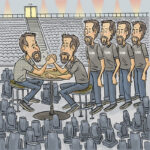The video design for American Idiot underwent a substantial transformation from California to New York, according to projection designer Darrell Maloney. In Berkeley, there were six video feeds going to 38 monitors routed through a switch so they could have different configurations of monitors. In the New York production, there are 43 monitors with a distinct feed going to each one, which allows Maloney and his team "to have different images on every individual monitor at any time. It also opened up how I could program transitions and patterns. One place this was used to great effect is in the opening number. I was able to treat each video sequence to look like the kind of TV it was playing on – 1950s, 1960s, 1970s, 1980s, etc. – since many of the monitors are dressed to look like older televisions."
Most of the original video/projection design took place over three months at Berkeley, and Maloney spent two more months revising and refining his work in New York. "The amount of media in this show is very high," he says. "It's the amount of media I used to create over the course of one year in my broadcast design business. There are over 600 pieces of media in the show made up of thousands and thousands of individual clips."
Maloney points out that in Berkeley they used many different brands of televisions, which was problematic, given all of their inherent color and contrast differences. He says it was impossible to get the content to look the same across all the monitors, which was most evident with the graphic pieces. They came up with a solution on Broadway: use Sony TVs exclusively.
For Maloney, the challenges in working with a set with dozens of TVs was how they could be used to tell the story and set place and mood without stealing focus from the performances. "The two techniques I found for this were pattern and chaos," he says. "If an image repeated over the monitors they became pattern and your eye could accept it and check in and out." The same applies when they were all different. "What would grab focus every time was one TV on by itself, or with different content. People would have a hard time looking away."
From "Inside Theatre" by Bryan Reesman, PLSN, July 2010


